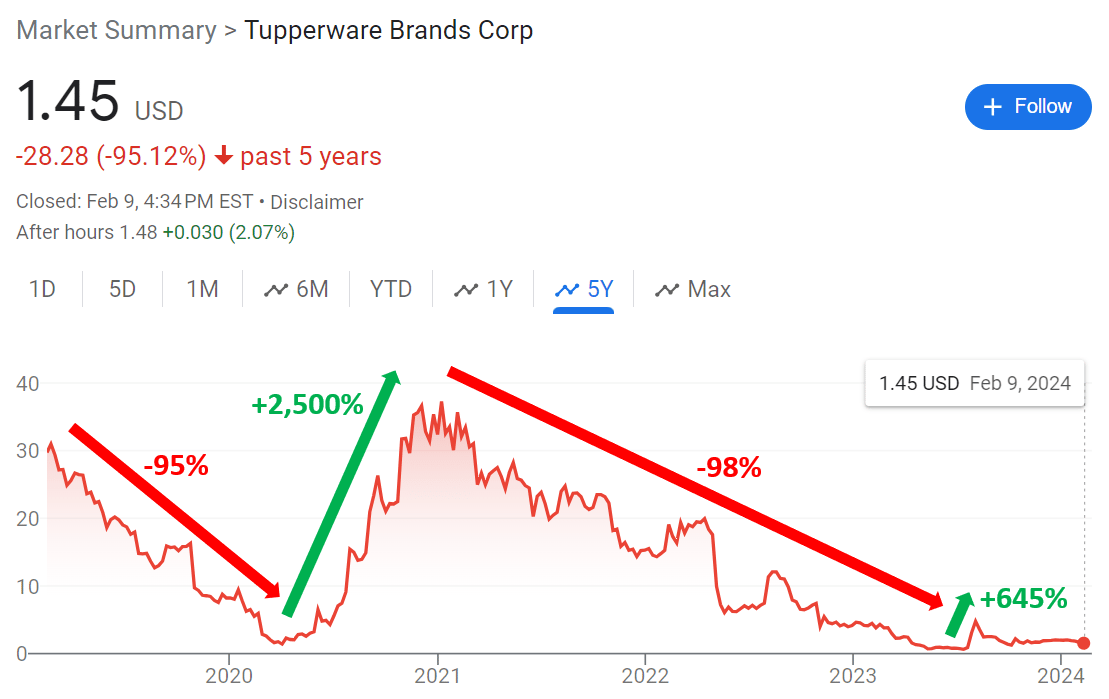Welcome to the 63rd Pari Passu newsletter.
Today, we are learning more about an iconic US brand: Tupperware. This company has a fascinating history: created a new product category, expanded to over 70 countries, went through two restructuring processes, and was recently named a meme stock.
Let’s dive in.
Please note, we published a revised and more comprehensive edition on Tupperware in June 2025.
Introduction
In 1946, the invention of Tupperware created the modern food storage category, revolutionizing how the world stores, prepares, and serves food. Today, Tupperware Brands Corp (NYSE: TUP) distributes its preparation, storage, and serving solutions for the kitchen and home in more than 70 countries around the world. From early 2020 to July 2023, Tupperware’s shares wildly fluctuated over the course of two debt restructurings, declining over 98% from a high of $37.29 to $0.62 per share. This article explores how such an iconic brand fell into such a precarious yet likely preventable position due to a combination of operational mismanagement and complacency in the face of growing competition, and the critical role that restructurings have played in giving the company multiple chances at a comeback [23].

History
After failing at his first business as a tree surgeon, Earl Tupper decided to get into the emerging world of plastics. In 1937, he obtained a job as a sample maker at a Dupont-affiliated plastics factory. During World War II, a type of plastic known as polyethylene had grown in prominence as a critical material in radar detectors, and DuPont was looking to expand its uses in commercial applications post-war. Tupper’s job allowed him to take polyethylene scrap home with him to experiment on, and he and his son would boil samples at home in an attempt to find the right balance and thickness so that the polyethylene flowed into the right shape and thickness. Tupper eventually developed a formulation he called “Poly-T: The Material of the Future,” which he believed had great potential. He applied this new technology to resealable plastic containers, under the company Tupperware, which he formed in 1946 to help families in post-war America save money by preventing food waste [1, 2, 4].
In contrast to former plastic containers, which were rigid, colorless, and typically sealed with tin foil or shower caps, Tupperware containers were softer, colorful, and resealable via airtight lids that closed with a satisfying “pop” sound. Tupper sold his kitchenware in department stores and a showroom in Manhattan, but sales were slow. People simply failed to understand the benefit of the products, an issue that Brownie Wise, a secretary in Florida, realized. Under her business, Patio Parties, she began to host demonstration “parties” for stay-at-home housewives, in which she would toss Tupperware containers filled with juice around living rooms, showing how reliable and convenient Tupperware products were. Hearing about Wise’s success, Tupper hired her in 1951 as vice president of marketing to develop a sales network. Wise’s strategy, which relied on party hosts to recruit attendees to sell under them, is now known as a form of multi-level marketing. At the time, this was a novel approach, and it became a hallmark of the company [1, 2, 4].
As the famous Tupperware parties grew, so did Tupperware’s sales, crossing over $25mm in 1954, then a significant sum. In 1958, Tupper subsequently sold the company to Rexall Drugs for $9mm and moved to Costa Rica. Rexall expanded the company, notably entering international markets in Europe and South America, before selling the company to Kraft in 1980. Using the same playbook of multilevel marketing and international expansion, Kraft continued to grow the company, but Kraft was not satisfied with Tupperware’s performance, and spun it out via IPO in 1996. Through the 1980s, Tupperware’s patents had expired, allowing competitors to create competing products that cut into sales. Additionally, with women entering the workforce in record numbers throughout the second half of the 20th century, Tupperware’s multilevel marketing strategy focused on stay-at-home mothers had begun to lose relevance. These headwinds proved to be early indicators of greater issues Tupperware has faced over the past few years [1, 2, 4].
Business Model
Subscribe to Pari Passu Premium to read the rest.
Become a paying subscriber of Pari Passu Premium to get access to this post and other subscriber-only content.
UpgradeA subscription gets you:
- Get Full Access to Over 150,000 Words of Content
- Institutional Level Coverage of Restructuring Deals

